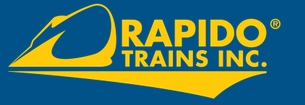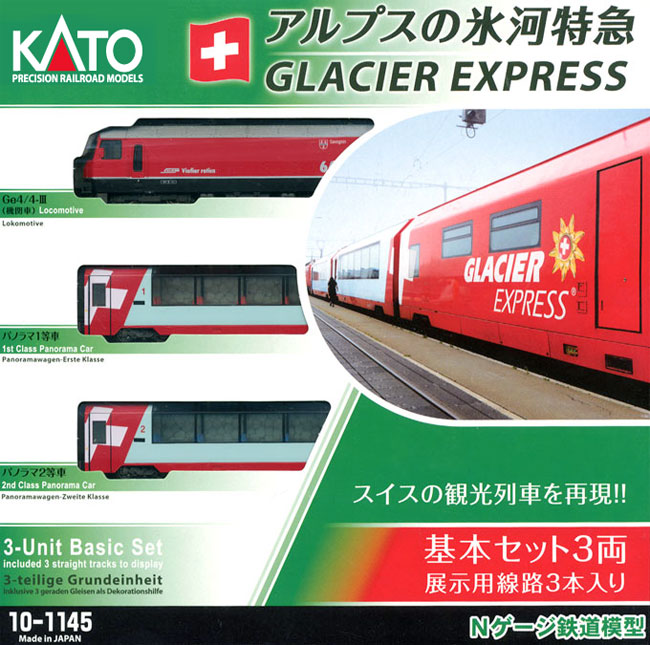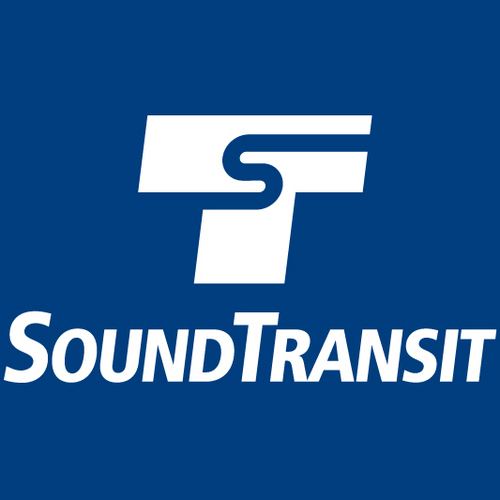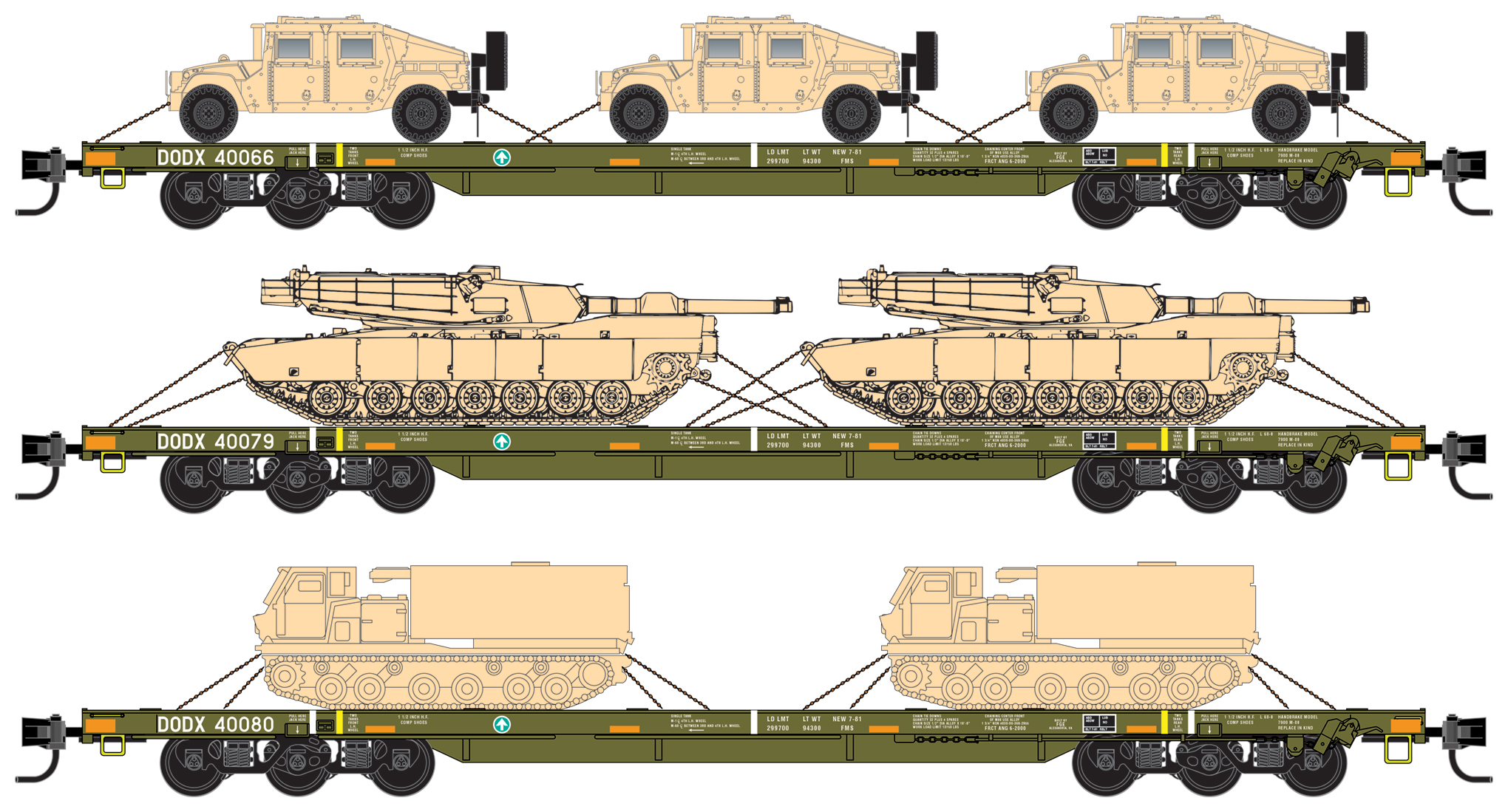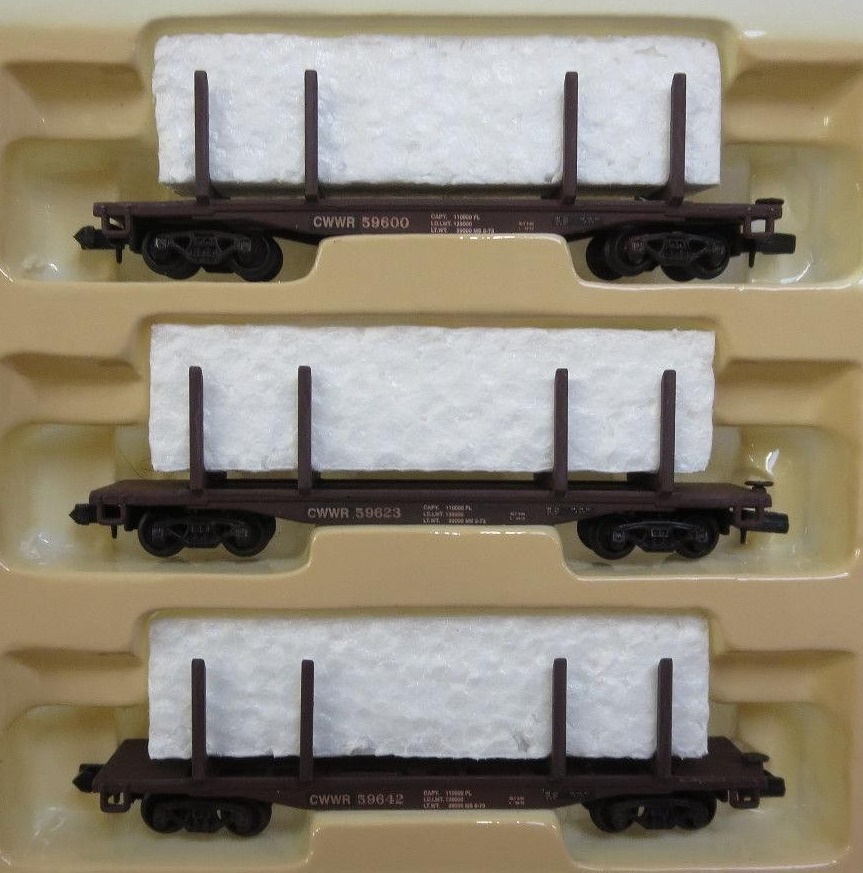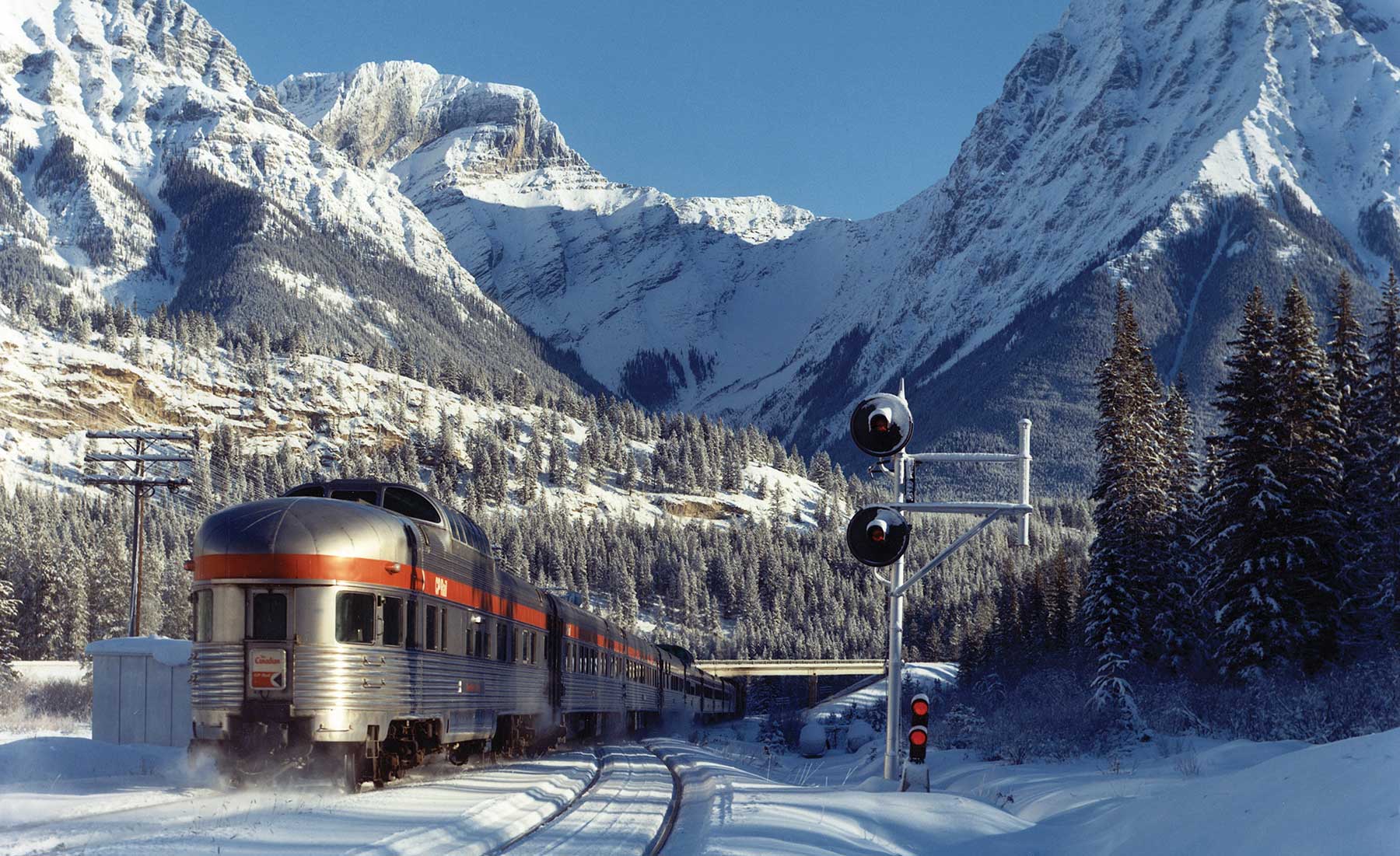Specific Item Information:
Set includes the following cars:
Baggage: 3008
Coach: 105
Coach: 119
Skyline: 504
Diner: Princess
Chateau: Chateau Roberval
Chateau: Chateau Lauzon
Manor: Grant Manor
Manor: Stuart Manor
Park: Banff Park
Set includes the following cars:
Baggage: 3008
Coach: 105
Coach: 119
Skyline: 504
Diner: Princess
Chateau: Chateau Roberval
Chateau: Chateau Lauzon
Manor: Grant Manor
Manor: Stuart Manor
Park: Banff Park
Model Information: Announced in June 2019. Contains 7 different body styles. Comes in 3 or 10-pack sets.
- Baggage-Dormitory
- Coach (set includes two)
- Skyline - Dome-Coach or Dome-Coffee Shop
- Diner
- Chateau Sleeper - 4 sections, 8 duplex roomettes, 3 bedrooms, 1 drawing room (set includes two)
- Manor Sleeper - 4 sections, 4 roomettes, 5 bedrooms, 1 compartment (set includes two)
- Park Car - Dome-Sleeper-Lounge-Observation
- Accurate Budd fluting profile
- Full interiors, including two optional Skyline interiors
- Track-powered interior lighting on DC and DCC
- Separate, etched metal grab irons and handrails
- Beautiful stainless steel finish
- Operating marker lights on all Park Cars
- Operating marker lights on all HEP enabled cars
Prototype History: In 1953, CPR placed an order for 155 stainless steel cars with Budd Company of Philadelphia that included 18 rear-end dome cars (Park series), 18 Skyline mid-train dome cars, 30 coaches, 18 dining cars and 71 sleeping cars (Manor and Château series). A subsequent order for 18 baggage-crew dormitory cars brought the final to total to 173 cars, sufficient for establishing an entirely new transcontinental service.
The Canadian was introduced by Canadian Pacific in April 1955 as its flagship transcontinental passenger train from Montreal and Toronto to Vancouver. It featured new FP9A locomotives and a consist of new stainless steel passenger cars built by Budd in Philadelphia.
The Canadian lasted with Canadian Pacific until 1978, when it was transferred to VIA Rail Canada. It continued to operate on the original Canadian Pacific routing until 1990, when it was moved to CN tracks. VIA refurbished and upgraded The Canadian to Head End Power and relaunched in 1992 under the “Silver and Blue” branding.
The train was recently upgraded again, adding “Prestige” service cars at the rear. These are Chateau Sleepers and Park Cars converted to gorgeous suites with queen-size beds and private showers. Despite suffering from poor timekeeping by “the freight railway,” The Canadian is still VIA’s flagship train. It still operates with the original Budd cars, and it still delights riders from around the world.
The Canadian could include as many as 30 cars, but is regularly between 18 and 22 cars long.
Information courtesy of Rapido Trains Inc..
About Streamlined/Lightweight passenger cars:
In the post-war period, passenger rail service boomed. In order to increase efficiency, the railroads set to replacing their old wood, steel and concrete heavyweight passenger cars with newer lightweight, streamlined cars. The new cars were made from stainless steel, aluminum and Cor-Ten steel. These cars required less motive power to pull and were cheaper to manufacture. Production was also concentrated in a few manufacturers rather than each railroad making its own. This led to standardization which further reduced costs. The new "lightweight" cars were also given "streamlined" designs to make them more visually appealing. Budd, Pullman Standard and ACF were all well known manufacturers of these cars.
The Canadian was introduced by Canadian Pacific in April 1955 as its flagship transcontinental passenger train from Montreal and Toronto to Vancouver. It featured new FP9A locomotives and a consist of new stainless steel passenger cars built by Budd in Philadelphia.
The Canadian lasted with Canadian Pacific until 1978, when it was transferred to VIA Rail Canada. It continued to operate on the original Canadian Pacific routing until 1990, when it was moved to CN tracks. VIA refurbished and upgraded The Canadian to Head End Power and relaunched in 1992 under the “Silver and Blue” branding.
The train was recently upgraded again, adding “Prestige” service cars at the rear. These are Chateau Sleepers and Park Cars converted to gorgeous suites with queen-size beds and private showers. Despite suffering from poor timekeeping by “the freight railway,” The Canadian is still VIA’s flagship train. It still operates with the original Budd cars, and it still delights riders from around the world.
The Canadian could include as many as 30 cars, but is regularly between 18 and 22 cars long.
Information courtesy of Rapido Trains Inc..
About Streamlined/Lightweight passenger cars:
In the post-war period, passenger rail service boomed. In order to increase efficiency, the railroads set to replacing their old wood, steel and concrete heavyweight passenger cars with newer lightweight, streamlined cars. The new cars were made from stainless steel, aluminum and Cor-Ten steel. These cars required less motive power to pull and were cheaper to manufacture. Production was also concentrated in a few manufacturers rather than each railroad making its own. This led to standardization which further reduced costs. The new "lightweight" cars were also given "streamlined" designs to make them more visually appealing. Budd, Pullman Standard and ACF were all well known manufacturers of these cars.
Road Name History: The Canadian Pacific Railway (CPR), formerly also known as CP Rail (reporting mark CP) between 1968 and 1996, is a historic Canadian Class I railroad incorporated in 1881. The railroad is owned by Canadian Pacific Railway Limited (TSX: CP, NYSE: CP), which began operations as legal owner in a corporate restructuring in 2001.
Headquartered in Calgary, Alberta, it owns approximately 23,000 kilometres (14,000 mi) of track all across Canada and into the United States, stretching from Montreal to Vancouver, and as far north as Edmonton. Its rail network also serves major cities in the United States, such as Minneapolis, Milwaukee, Detroit, Chicago, and New York City.
The railway was originally built between Eastern Canada and British Columbia between 1881 and 1885 (connecting with Ottawa Valley and Georgian Bay area lines built earlier), fulfilling a promise extended to British Columbia when it entered Confederation in 1871. It was Canada's first transcontinental railway, but currently does not reach the Atlantic coast. Primarily a freight railway, the CPR was for decades the only practical means of long-distance passenger transport in most regions of Canada, and was instrumental in the settlement and development of Western Canada. The CP became one of the largest and most powerful companies in Canada, a position it held as late as 1975. Its primary passenger services were eliminated in 1986, after being assumed by Via Rail Canada in 1978. A beaver was chosen as the railway's logo because it is the national symbol of Canada and was seen as representing the hardworking character of the company.
The company acquired two American lines in 2009: the Dakota, Minnesota and Eastern Railroad and the Iowa, Chicago and Eastern Railroad. The trackage of the ICE was at one time part of CP subsidiary Soo Line and predecessor line The Milwaukee Road. The combined DME/ICE system spanned North Dakota, South Dakota, Minnesota, Wisconsin, Nebraska and Iowa, as well as two short stretches into two other states, which included a line to Kansas City, Missouri, and a line to Chicago, Illinois, and regulatory approval to build a line into the Powder River Basin of Wyoming. It is publicly traded on both the Toronto Stock Exchange and the New York Stock Exchange under the ticker CP. Its U.S. headquarters are in Minneapolis.
After close of markets on November 17, 2015, CP announced an offer to purchase all outstanding shares of Norfolk Southern Railway, at a price in excess of the US$26 billion capitalization of the United States-based railway. If completed, this merger of the second and fourth oldest Class I railroads in North America would have formed the largest single railway company on that continent, reaching from the Pacific coast to the Atlantic coast to the Gulf Coast. The merger effort was abandoned by Canadian Pacific on April 11, 2016, after three offers were rejected by the Norfolk Southern board.
Read more on Wikipedia and on Canadian Pacific official website.
Headquartered in Calgary, Alberta, it owns approximately 23,000 kilometres (14,000 mi) of track all across Canada and into the United States, stretching from Montreal to Vancouver, and as far north as Edmonton. Its rail network also serves major cities in the United States, such as Minneapolis, Milwaukee, Detroit, Chicago, and New York City.
The railway was originally built between Eastern Canada and British Columbia between 1881 and 1885 (connecting with Ottawa Valley and Georgian Bay area lines built earlier), fulfilling a promise extended to British Columbia when it entered Confederation in 1871. It was Canada's first transcontinental railway, but currently does not reach the Atlantic coast. Primarily a freight railway, the CPR was for decades the only practical means of long-distance passenger transport in most regions of Canada, and was instrumental in the settlement and development of Western Canada. The CP became one of the largest and most powerful companies in Canada, a position it held as late as 1975. Its primary passenger services were eliminated in 1986, after being assumed by Via Rail Canada in 1978. A beaver was chosen as the railway's logo because it is the national symbol of Canada and was seen as representing the hardworking character of the company.
The company acquired two American lines in 2009: the Dakota, Minnesota and Eastern Railroad and the Iowa, Chicago and Eastern Railroad. The trackage of the ICE was at one time part of CP subsidiary Soo Line and predecessor line The Milwaukee Road. The combined DME/ICE system spanned North Dakota, South Dakota, Minnesota, Wisconsin, Nebraska and Iowa, as well as two short stretches into two other states, which included a line to Kansas City, Missouri, and a line to Chicago, Illinois, and regulatory approval to build a line into the Powder River Basin of Wyoming. It is publicly traded on both the Toronto Stock Exchange and the New York Stock Exchange under the ticker CP. Its U.S. headquarters are in Minneapolis.
After close of markets on November 17, 2015, CP announced an offer to purchase all outstanding shares of Norfolk Southern Railway, at a price in excess of the US$26 billion capitalization of the United States-based railway. If completed, this merger of the second and fourth oldest Class I railroads in North America would have formed the largest single railway company on that continent, reaching from the Pacific coast to the Atlantic coast to the Gulf Coast. The merger effort was abandoned by Canadian Pacific on April 11, 2016, after three offers were rejected by the Norfolk Southern board.
Read more on Wikipedia and on Canadian Pacific official website.
Brand/Importer Information: Rapido Trains Inc. is a high-end manufacturer of model trains and accessories in HO, OO and N (North American 1:160 and British 1:148) scales. The firm's mission is to recreate the entire rail travel experience, from fully-detailed interiors and under-frames on models to fully-wired telephone poles for model railroads.
The name RAPIDO was introduced by Canadian National in 1965 to headline the railway's high-speed intercity passenger services. Until the mid-1980s, RAPIDO stood for fast schedules, frequent trains, and superb service.
Today, Rapido Trains continues the RAPIDO concept with state-of-the-art models and attention to fine detail. This company is not related to the venerable (and now defunct) German manufacturer Arnold Rapido, nor the present-day Arnold (which is owned by the United Kingdom's Hornby), Canadian based Rapido Trains was founded in 2003.
The name RAPIDO was introduced by Canadian National in 1965 to headline the railway's high-speed intercity passenger services. Until the mid-1980s, RAPIDO stood for fast schedules, frequent trains, and superb service.
Today, Rapido Trains continues the RAPIDO concept with state-of-the-art models and attention to fine detail. This company is not related to the venerable (and now defunct) German manufacturer Arnold Rapido, nor the present-day Arnold (which is owned by the United Kingdom's Hornby), Canadian based Rapido Trains was founded in 2003.
Item created by: Powderman on 2020-02-29 10:41:11. Last edited by gdm on 2020-06-01 10:02:08
If you see errors or missing data in this entry, please feel free to log in and edit it. Anyone with a Gmail account can log in instantly.
If you see errors or missing data in this entry, please feel free to log in and edit it. Anyone with a Gmail account can log in instantly.



